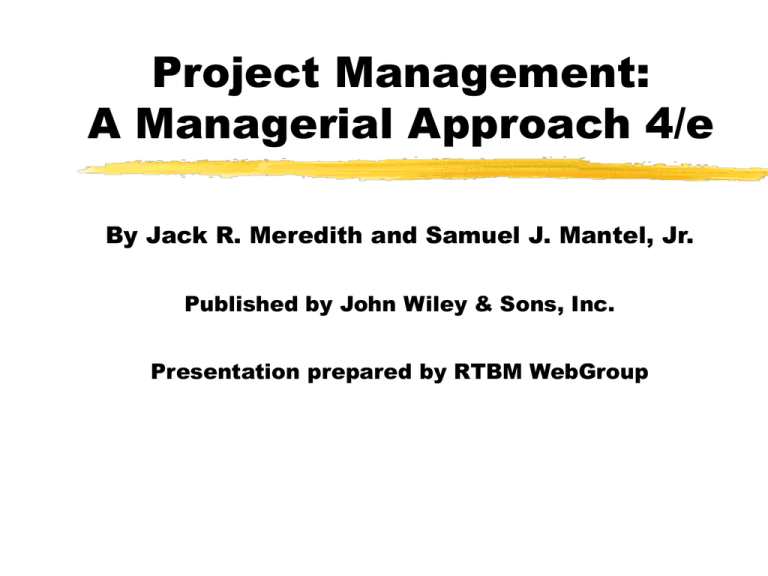
Project Management:
A Managerial Approach 4/e
By Jack R. Meredith and Samuel J. Mantel, Jr.
Published by John Wiley & Sons, Inc.
Presentation prepared by RTBM WebGroup
Project Management
A Managerial Approach
Chapter 8
Scheduling
Scheduling
A schedule is the conversion of a
project action plan into an operating
timetable
It serves as the basis for monitoring
and controlling project activity
Taken together with the plan and
budget, it is probably the major tool
for the management of projects
Chapter 8-1
Scheduling
In a project environment, the
scheduling function is more important
than it would be in an ongoing
operation
Projects lack the continuity of day-today operations and often present much
more complex problems of
coordination
Chapter 8-2
Scheduling
The basic approach of all scheduling
techniques is to form a network of
activity and event relationships
This network should graphically portray
the sequential relations between the
tasks in a project
Tasks that must precede or follow
other tasks are then clearly identified,
in time as well as function
Chapter 8-3
Scheduling
Such networks are a powerful tool for
planning and controlling a project and
have the following benefits:
It is a consistent framework for planning,
scheduling, monitoring, and controlling the
project
It illustrates the interdependence of all
tasks, work packages, and work elements
It denotes the times when specific
individuals must be available for work on a
Chapter 8-4
given task
Scheduling
Network benefits (cont.):
It aids in ensuring that the proper
communications take place between
departments and functions
It determines an expected project completion
date
It identifies so-called critical activities that, if
delayed, will delay the project completion time
It identifies activities with slack that can be
delayed for specific periods without penalty
Chapter 8-5
Scheduling
Network benefits (cont.):
It determines the dates on which tasks may be
started - or must be started if the project is to
stay on schedule
It illustrates which tasks must be coordinated
to avoid resource timing conflicts
It illustrates which tasks may run, or must be
run, in parallel to achieve the predetermined
project completion date
It relieves some interpersonal conflict by clearly
Chapter 8-6
showing task dependencies
Network Techniques:
PERT and CPM
With the exception of Gantt charts, the most
common approach to scheduling is the use of
network techniques such as PERT and CPM
The Program Evaluation and Review
Technique was developed by the U.S. Navy in
1958
The Critical Path Method was developed by
DuPont, Inc during the same time period
Chapter 8-7
Network Techniques:
PERT and CPM
PERT has been primarily used for
research and development projects
CPM was designed for construction
projects and has been generally
embraced by the construction industry
The two methods are quite similar and
are often combined for educational
presentation
Chapter 8-8
Terminology
Activity - A specific task or set of tasks that
are required by the project, use up resources,
and take time to complete
Event - The result of completing one or more
activities. An identifiable end state occurring
at a particular time. Events use no resources.
Network - The combination of all activities
and events define the project and the activity
precedence relationships
Chapter 8-9
Terminology
Path - The series of connected activities
(or intermediate events) between any two
events in a network
Critical - Activities, events, or paths
which, if delayed, will delay the
completion of the project. A project’s
critical path is understood to mean that
sequence of critical activities that connect
the project’s start event to its finish event
Chapter 8-10
Terminology
An activity can be in any of these conditions:
It may have a successor(s) but no
predecessor(s) - starts a network
It may have a predecessor(s) but no
successor(s) - ends a network
It may have both predecessor(s) and
successor(s) - in the middle of a network
The interconnections depend on the
technological relationships described in the
action plan
Chapter 8-11
Drawing Networks
Activity-on-Arrow (AOA) networks use arrows
to represent activities while nodes stand for
events
Activity-on-Node (AON) networks use nodes
to represent activities with arrows to show
precedence relationships
The choice between AOA and AON
representation is largely a matter of personal
preference
Chapter 8-12
Drawing Networks
Chapter 8-13
Gantt Charts
The Gantt chart shows planned and actual progress
for a number of tasks displayed against a horizontal
time scale
It is an effective and easy-to-read method of
indicating the actual current status for each set of
tasks compared to the planned progress for each
item of the set
It can be helpful in expediting, sequencing, and
reallocating resources among tasks
Gantt charts usually do not show technical
dependencies
Chapter 8-14
Scheduling
Chapter 8-15
Gantt Charts
There are several advantages to the use of
Gantt charts:
Even though they may contain a great deal of
information, they are easily understood
While they may require frequent updating, they
are easy to maintain
Gantt charts provide a clear picture of the
current state of a project
They are easy to construct
Chapter 8-16
Summary
Scheduling is particularly important to
projects because of the complex
coordination problems
The network approach to scheduling offers
a number of specific advantages of special
value for projects
Critical project tasks typically constitute
fewer than 10 percent of all the project
tasks
Chapter 8-17
Summary
Although research indicates technological
performance is not significantly affected by
the use of PERT/CPM, there did seem to be a
significantly lower probability of cost and
schedule overruns
Network techniques can adopt either an
activity-on-node or activity-on-arc framework
without significantly altering the analysis
Chapter 8-18
Summary
Networks are usually constructed from
left to right, indicating activity
precedence and event times as the
network is constructed
Gantt charts are closely related to
network diagrams, but are more easily
understood and provide a clearer
picture of the current state of the
project
Chapter 8-19
Scheduling
Questions?
Scheduling
Picture Files
Scheduling
Figure 8-1
Scheduling
Figure 8-2
Scheduling
Figure 8-3
Scheduling
Figure 8-5
Scheduling
Figure 8-6
Scheduling
Figure 8-7
Scheduling
Figure 8-8
Scheduling
Figure 8-9
Scheduling
Figure 8-10
Scheduling
Figure 8-11
Scheduling
Figure 8-12
Scheduling
Figure 8-13
Scheduling
Figure 8-14
Scheduling
Figure 8-15
Scheduling
Figure 8-16
Scheduling
Figure 8-17
Scheduling
Figure 8-20
Scheduling
Figure 8-21
Scheduling
Figure 8-22
Scheduling
Figure 8-23
Scheduling
Figure 8-24
Scheduling
Figure 8-25
Scheduling
Figure 8-26
Scheduling
Figure 8-27
Scheduling
Figure 8-28
Scheduling
Figure 8-30
Scheduling
Table Files
Scheduling
Scheduling
Scheduling
Scheduling
Scheduling
Scheduling
Copyright © 2000 John Wiley & Sons, Inc. All rights
reserved. Reproduction or translation of this work
beyond that permitted in Section 117 of the 1976 United
States Copyright Act without the express written
permission of the copyright owner is unlawful. Request
for further information should be addressed to the
Permissions Department, John Wiley & Sons, Inc. The
purchaser may make back-up copies for his/her own use
only and not for distribution or resale. The Publisher
assumes no responsibility for errors, omissions, or
damages, caused by the use of these programs or from
the use of the information contained herein.







